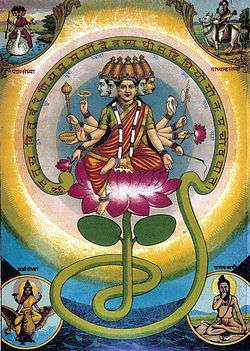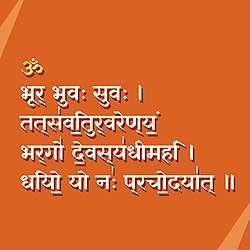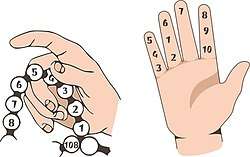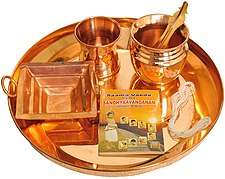Sandhyavandanam
Sandhyavandanam (Sanskrit: संध्यावन्दनम्, sandhyāvandanam, lit. 'salutation to (Goddess) Sandhyā' or 'salutation during the time of Sandhyā') is a mandatory religious ritual supposed to be daily performed, traditionally, by Dvija communities of Hindus,[1][2] particularly those initiated through the sacred thread ceremony referred to as the Upanayanam and instructed in its execution by a Guru, in this case one qualified to teach Vedic ritual.[2] Sandhyopasana is considered as a path to attain salvation (moksha).
Practice of Sandhyā in Ramayana and Mahabharata by Rama and Krishna can be observed. In Balakanda (23.2, 23.2) of Ramayana, Viswamitra wakes Rama and Lakshmana up at the break of the dawn for the worship of sandhyā. In Udyogaparva (82.21) of Mahabharata there is reference to Krishna performing Sandhya.[3]
Definition of Sandhyā

The conjuction of day and night - that time when there are neither stars nor sun - the twilight is called Sandhyā. The word Sandhyā, therefore, secondarily means all those acts to be performed at that particular time as daily practice. It is defined in smritis as following[4]:69
- As per Vṛddha Yājñavalkya, Sandhyā is a particular devatā, presiding over these portions of the day. The morning is called Gāyatrī (who is white in colour), the mid-day is Sāvitrī (who is red), the evening is named Sarasvatī (who is black or dark blue).
- According to Mādhava, it is thus called because this is performed at the time called Sandhyā (i.e. Sandhyākāla).
- According to Nṛsimha, it is thus called because it is complete meditation.[note 1]
- According to Vyāsa, it is thus called by men as it is performed during the transition moment (sandhi) of the day such as twilight times of dawn and dusk and solar noon.[note 2]
Thus, the Sandhyāvandanam consists of recitation from the Vedas, accompanied by ritual. These rituals are performed three times a day - at morning (prātassaṃdhyā), noon (mādhyāhnika) and evening (sāyaṃsaṃdhyā). Sir Monier-Williams offer the meaning of saṃdhyā as juncture of the two divisions of the day (morning and evening) and also defined as "the religious acts performed by Brahmans and twice-born men at the above three divisions of the day".[5]
A praise of sandhya devata is given below
yā sandhyā sā jagatsūtirmāyātītā hi niṣkalā
īśvarī kevalā śaktistattvatraya samudbhavā
dhyātvā'rkamaṇḍalagatāṃ sāvitrīṃ vai japedbudhaḥ[6][note 3]
Description of Gayatri
In Mahanarayana Upanishad[note 4]. of Krishna Yajurveda, Gayatri is described as white-colored (Sanskrit: श्वेतवर्णा, śvetavarṇā), having the gotra of sage viswamitra (Sanskrit: सान्ख्यायनस गोत्रा, sānkhyāyanasa gotrā) , composed of 24 letters (Sanskrit: चतुर्विंशत्यक्षरा, caturviṃśatyakṣarā), three-footed (Sanskrit: त्रिपदा, tripadā), six-bellied (Sanskrit: षट्कुक्षिः, ṣaṭkukṣiḥ), five-headed (Sanskrit: पञ्चशीर्षः, pañcaśīrṣaḥ) and the one used in Upanayana of dvijas (Sanskrit: उपनयने विनियोगः, upanayane viniyogaḥ).[7]
Taittirīya Sandhya Bhāṣyam of Sri Krishna Pandita mentions that the three feet of Gayatri is supposed to represent the first 3 vedas (Ṛk, Yajus, Sāma). The six bellies are supposed to represent 4 cardinal directions, along with the two more directions, Ūrdhva (Zenith) and Adhara (Nadir). The five heads represent 5 among the Vedangas, namely, vyākaraṇa, śikṣā, kalpa, nirukta and jyotiṣa.[8]
Gayatri mantra has 24 letters. They are 1.tat (तत्), 2.sa (स), 3.vi (वि), 4.tur (तुर्), 5.va (व), 6.re (रे), 7.ṇi (णि), 8.yaṃ (यं), 9.bhar (भर्), 10.go (गो), 11.de (दे), 12.va (व), 13.sya (स्य), 14.dhī (धी), 15.ma (म), 16.hi (हि), 17.dhi (धि), 18.yo (यो), 19.yo (यो), 20.naḥ (नः), 21.pra (प्र), 22.co (चो) 23.da (द) and 24.yāt (यात्).
When counting the letters, the word vareṇyam (वरेण्यं) is treated as vareṇiyam (वरेणियं). But, while chanting, it ought to be chanted as vareṇyam only.
Sandhyākāla
Sandhyākāla is the time to perform Sandhyā. Day is divided by 5 parts, each having an interval of 2 hour and 24 minutes. They are prātaḥ-kālaḥ (early morning), pūrvahna (forenoon), madhyāhna (around noon), aparāhna (afternoon), sāyāhna (evening). As per Hindu traditional calander, the day[note 5] starts with sunrise (i.e. from midnight of previous night until sunrise is considered part of previous day).[9]
Sandhyākāla is totally 72 minutes (i.e. 3 ghaṭīs).[10]:218
- Prātassandhyā spans from two ghaṭīs[note 6] before sunrise and until one ghaṭī after it.
- Madhyāhna sandhyā spans from one and half ghaṭī before noon and until one and half ghaṭī after it.
- Sāyam sandhyā spans from one ghaṭī before sunset and until two ghaṭīs after it.
Suppose, sunrise and sunset are 6AM and 6PM, then Prātassandhyā and Sāyamsandhyā times starts from 5.12AM (until 6.24AM) and 5.36PM (until 6.48PM) respectively. Similarly, Madhyāhnasandhyā time starts from 11.24AM (until 12.36PM).
In case, it is not possible to do sandhyā in this time, a grace period (gauṇakāla) of 2 hours[note 7] after end of original span (mukhyakāla) of sandhyā is allowed. In other words, Prātassandhyā and Madhyāhnasandhyā and should be finished before onset of pūrvahna and aparāhna respectively. Likewise, Sāyamsandhyā should be finished before end of pradosha.[note 8]
If sunrise and sunset are 6AM and 6PM, then the three sandhyas can be performed until 8.24AM, 1.48PM, 8.24PM, respectively. If that is also exceeded, then Prāyaścitta arghya (i.e. fourth one) has to given.
Direction of Sandhyāvandanam
Sandhyāvandanam should be done facing the East in the morning sandhyā (doing Gāyatrījapa until sunrise), the North in the noon and the West in the evening sandhyā (doing Gāyatrījapa until stars rise).[note 9] In the evening, only āchamana part is performed in East or North.
Benefit of Sandhyopāsana
As per Yama, Atri, the dvija who performs Sandhyā every day without fail attains moksha (i.e. salvation) at the end of his life (i.e. videha mukti).[note 10]. There is saying from vedas, "yatsandhyāmupāsate brahmaiva tadupāsate" (who does Sandhyopāsana are (indeed) worshiping the parabrahman only).
Parts of Sandhyā Vandanam
As per the work Sandhyātattvasubhodini,[10]:133 the Sāṅgopāṅga Sandhyāvandanam (lit. Sandhyāvandanam with all the essential and subsidiary parts) consists of different components termed as aṅgas (lit. limbs). Apart from the principal one (aṅgi), it has 5 anterior parts (pūrvāṅga) and 5 posterior parts (uttarāṅga).
Before commencement of the 5 pūrvāṅgas, there exist 3 angas, namely, Ācamanaṃ (आचमनम्), Prāṇāyāmaḥ (प्राणायामः) and Sankalpaḥ (सङ्कल्पः), which are not mentioned separately. These 5 pūrvāṅgas are:
- Prathama Mārjanaṃ (प्रथममार्जनम्, First cleansing)
- Mantrācamanaṃ (मन्त्राचमनम्, Water-sipping via Vedic mantras)
- Punarmārjanaṃ (पुनर्मार्जनम्, Second cleansing. Also known as Dvitīyamārjanaṃ)
- Pāpavimocana Mantram (पापविमोचन मन्त्रम्, Liberation from sins. Also known as Aghamarṣaṇa)
- Arghyapradānam (अर्घ्यप्रदानम्, Offering of water to the Sun (Sūrya))
The principal part is the Sandhyopāsanā mantram (सन्ध्योपासना मन्त्रम्), which involves contemplation on Brahman, referred as 'Brahmabhāvanam'. This Upāsanā mantra is also referred as Dhyānam part in Sandhyāvandanam by the smritis. However, few smritis such as by Manu and Āśvalāyana consider Gāyatrījapaḥ as the principle one.[4]:69 The 5 uttarāṅgas are:
- Gāyatrījapaḥ (गायत्रीजपः, Deep meditation with the chanting of Gayatri mantra)
- Sūrya-Upasthānaṃ (सूर्योपस्थानम्, Adoration in the presence of the Sun with Vedic mantras)
- Dik Namaskāraḥ (दिङ्नमस्कारः, Salutation to the Devatas in all the cardinal directions)
- Bhūmyākāśa ābhivandanam (भूम्याकाशाभिवन्दनम्, Respectful salutation to the Sky (Dyaus Pitṛ) and the Earth (pṛthivī))
- Abhivādanam (अभिवादनम्, Formal salutation by reciting ones' Gotra and Pravara)
In addition to the above Vedic components of the Sandhyāvandanam, many include the following due to Tantric influences:
- Gayatri tarpaṇaṃ (तर्पणम्), nyāsa (न्यासः) and Mudrāpradarśanam (मुद्राप्रदर्शनम्) are performed in Yajurveda Sandhyāvandanam due to Śiṣṭācāra.
- Navagraha tarpaṇam are offerings made every day to each of the 9 planets.
Accessories for Sandhyā
Pañcapātra
Pañcapātra is the set of holy utensils used for Hindu rituals containg plate (thāḷī, laghupātra) and ritualistic spoon (uddhariṇī/ācamanī).
Āsana
As per vyāsa and parāśara, a seat (Āsana) for japa should be made of
kauśeyaṃ kambalañcaiva ajinaṃ ca
dārujaṃ tālapatraṃ ca āsanaṃ parikalpayet[note 11]
The seat should be of silk (kauśeya) or blanket (kambala) or skin (ajina) or wood (dāruja) or (palm) leaves (tālapatra).[4]:67
The fruit of using different seats are mentioned as
kṛṣṇājine jñānasiddhirmokṣaśrīvyāghracarmaṇi
kuśāsane karmasiddhiḥ paṭemokṣamavāpnuyāt
vastrāsane ca dāridrayaṃ pāṣāṇe rogasaṃbhavaḥ
medinyaṃ duḥkhamāpnoti kāṣṭhe bhavanti niṣphalam
tṛṇe dhanayaśohāniḥ pallave cittavibhramaḥ[note 12]
The skin of black antelope (kṛṣṇājinacarma/mṛgacarma) gives knowledge, that of tiger (vyāghracarma) emancipation and all , So also a spotted blanket gives all desires. The bamboo seat causes poverty, the stone (pāṣāṇa) causes disease; the earth (medinī), causes sorrow, the painted wooden seat (kāṣṭha) causes ill-luck; straw (tṛṇa) seat causes loss of wealth and fame, a seat made of leaves (pallava) causes delusion or mental hallucination.[4]:67
Traditional mat made from Kuśa grass (kuśāsana or dārbhasana), a necessity for pooja and a must have for yoga. This sacred kuśa plant (known locally in India as Malayalam:ദർഭ, Kannada:ದರ್ಭೆ, Tamil:தருப்பைப்பு, ல், Telugu:దర్భ) was mentioned in the Rig Veda for use in sacred ceremonies and also as a seat for priests and the gods.[11] Kusha grass is specifically recommended by Lord Krishna in the Bhagavad Gita as part of the ideal seat for meditation.[12] This amazing mat is woven by veteran weavers from India. According to early Buddhist accounts, it was the same kuśa grass material that was used by Gautama Buddha for his meditation seat when he attained enlightenment.[13]
Japamāla
A rosary (Japamāla), if available, can be used for counting the number of recitations in Gayatri japa. Āsanamantra is to be chanted before taking seat. The rosary may made from Rudraksha, Tulasi, gem (ratna) or crystal (sphaṭika) and consists of 108 beads or 54 beads or 27 beads.
Tilakadhāraṇa
Tilakadhāraṇa means marking of holy mark (Tilaka) on the forehead as per the local tradition before commencement of Sandhyā. kumkuma, gandha, gopichandana and bhasma can be used for marking. Saivaites and Smartas mark tripuṇḍram, while, vaishnavaites mark ūrdhvapuṇḍram. Tripuṇḍram (Sanskrit:त्रिपुण्ड्रम्) or Tripuṇḍraka refers to the “three parallel lines of ash marks over the forehead”, according to the Śivapurāṇa 1.18.[14] Ūrddhvapuṇḍram (ऊर्द्ध्वपुण्ड्रम्) is a perpendicular line on the forehead made with Sandal, &c. a Vaishnava mark.[15] It is strictly advised against doing Sandhyā without tilakadhāraṇa.[note 13]
Yajurveda Sandhyāvandanam
It is usual practice to recite mantras from one's own Veda in Sandhyāvandanam. The procedure below are given w.r.t. the Taittirīya śākha of (Kriṣna) Yajurveda as followed by Telugu people adhering to the smarta tradition.[17][18][19][20] The mantras used in Prāṇāyāma, Mantrācamana, Gāyatrī āhvānam, Devatānamaskāraḥ and Gāyatrī Prasthānam are directly from Mahanarayana Upanishad (Andhra rescension containing 80 anuvakas).[21]
Mānasasnānam
Sandhyāvandanam starts with mānasasnānam (lit. mind bath) that involves viṣṇusmaraṇaṃ (remembrance of Lord Vishnu):
apavitraḥ pavitro vā sarvāvasthāṃ gato'pi vā
yaḥ smaret puṇḍarīkākṣaṃ saḥ bāhyābhyantaraḥ śuciḥ
puṇḍarīkākṣa puṇḍarīkākṣa puṇḍarīkākṣa[note 15]
Either pure or impure, passing through all the conditions of material life,
if remember the lotus-eyed, then, one becomes externally and internally clean.
By uttering the above chant, water is sprinkled on head thrice.
Ācamana
Achamana involves sipping of water three times for purging the mind of all thoughts of ‘I’, ‘My’, ‘Mine’ for contemplation of ‘Supreme Atman”.
Achamana ought to be done only in two directions, namely, East or North. There are three types of Āchamanam,[22] namely, Śrautācamanam (Sanskrit: श्रौताचमनम्), Smṛtyācamanam (Sanskrit: स्मृत्याचमनम्)[note 16] and Purāṇācamanam (Sanskrit: पुराणाचमनम्)[note 17].
Since, this is the first āchamana in Sandhyāvandanam, the sipping of water should be Purāṇācamana (i.e. 24 names of Vishnu starting with Om Keśavāya swāha & Co). Then, one Smṛtyācāmana and Bhūtocchāṭana are performed.
Prāṇāyāma
Prāṇāyāma is (Prāṇa) Breathing (āyamaḥ) regulation. Done scientifically, pranayama improves oxygen supply, expels carbon dioxide, helps blood circulation, improves concentration, memory power and general health. As per sage Viswamitra, it is defined as below
saptavyāhṛtibhiścaiva prāṇāyāmaṃpuṭikṛtam
vyāhṛtyādi śiroṃtaṃca prāṇāyāma trayatrikam (viśvāmitra kalpaḥ 2.3)[note 18]
śirāsā sārdhvaṃ japedvyāhṛti pūrvikām
prati praṇava samyuktaṃ trirayaṃ prāṇāyāmaḥ (yājñavalkyasmṛti 2.23)
It consists of three processes, first is inhalation that involves breathing in slowly through the right nostril; called as pūraka (पूरकः). The second is retention that involves retaining the breath by closing both nostrils, for a period more or less prolonged; called as kumbhaka (कुम्भक). As per Yajnavalkya smriti, the Gayatri mantra with its śiras (head)[note 19] and preceeded by the 7 vyāhṛtīs;[note 20] to each of which the syllable Om should be added. This chanting has to be done thrice during kumbhaka. Then, the third is exhalation that involves breathing out slowly through the other nostril; called as recaka (रेचकः).
Sankalpa
- Sankalpa means taking the resolve. It should be always done after careful contemplation, in a calm and positive frame of mind mustering the will to act upon. Even when one is engaged in appeasing 'God', such act should be done with 'His' approval.
Then, Jalābhimantraṇam has to be done with Brahmamukha mantra (i.e. Gayatri mantra) to purify the water just before Prathama Mārjana.
Prathama Mārjana
Marjanam is also known as Mantrasnānam (bath with mantras). This is a process of sanitizing and revitalizing body and mind. Mantras commonly used here adore water as a source of nourishment, medicines and energy. This awareness would encourage to be frugal in its use and deter pollution.
Mantrācamana
Mantrācamanaṃ or Jalaprāśanaṃ is sipping of water by reciting relevant vedic mantras for internal purification so that one becomes spiritually fit to perform ritualistic act. This is a 'Jnana Yajna' where one introspects, repents for the sins committed and surrenders to the Lord. This is done wishfully.One offers water consecrated by mantras in the fire present in the mouth – contemplating that body, mind and heart have been cleansed.Sins specified include : Mental, i.e. evil thoughts, anger, Oral, i.e. lies, abuses and Physical, i.e. theft, prohibited sexual act, consuming undesirable food, crushing creatures under the feet. Seek emancipation of sins committed during the day or night.
Punarmārjana
Smṛtyācāmana is performed two times and then Punarmārjanaṃ or Second cleansing involving more Vedic mantras is done.
Aghamarṣaṇaṃ
Aghamarṣaṇaṃ is intended to liberate from sins with a few drops of water in the hand, chant the related mantra and mentally induce 'Pāpapuruṣa' to come out through the nose into the water and it is throw it away to the left side. In Yajurveda sandhya, the meaning of mantra is
Om, even as the perspiring gets relief from the shade of the tree, as bathing removes the impurities of the body, as the ghee becomes purified by its purifying agent. (Yajurveda, Taittiriya Brahmana, 2-4-4-43)
So let the Waters purify me from all sins.
Arghyapradāna

One Smṛtyācāmana and one Prāṇāyāma are performed. Then, arghyapradāna means offering of water to the Sun with two hands as laid down in the Grihyasutras. A handful of water is taken in two hands cupped together, standing in front of the Sun. Then recite the Sāvitri (i.e. Gayatri mantra) preceded by the vyāhṛtis and the pranava (i.e. om kāra). Arghya has to be offered thrice. These three arghyas destroy the mandeha rakshasas fighting the Sun every sandhya.[note 21]. If there is delay in sandhya by exceeding the sandhya time, then Prāyaścitta arghya (i.e. fourth one) is given.
Sandhyopāsanā (Dhyāna)
The sun is then contemplated as the brahman (i.e.the supreme reality) through the mantra asā'vādityo brahmā (Sanskrit:असाऽवादित्यो ब्रह्मा, lit. this Āditya is indeed the Brahman). Smartas who adhere to advaita utter additional verse So'ham asmi. Aham brahmāsmi. (Sanskrit:सोऽहमस्मि। अहं ब्रह्मास्मि॥, lit. this is I[note 22]. I am Brahman[note 23]).
Tarpaṇaṃ
Then, two times Smṛtyācāmana and three times Prāṇāyāma are performed. Tarpana is a term in the Vedic practice which refers to an offering made to divine entities, where some water is taken in the right hand and poured over the straightened fingers. In Sandhyā, Four devatarpaṇas are offered for Sandhyā devata.[note 24]
Gāyatrī āhvānam
In Gāyatrī āhvānam (lit. invitation of Gāyatrī), the Sandhyādevata is invited by relevant Vedic mantras. One Śrautācāmana and one Prāṇāyāma are performed. Then Gāyatrī japa sankalpa is told.
Nyāsa
In nyāsa mental appropriation or assignment of various parts of the body to tutelary deities is done just before and after Gāyatrī japam. There are two nyāsas, karanyāsa and aṅganyāsa that involves "ritualistic placing of the finger over the different parts of the body as prescribed" with related ancillary mantras. When done before japa, aṅganyāsa ends with the utterance digbandhaḥ (invoking protection from eight cardinals) and when done after, it ends with the utterance digvimokaḥ (releasing the protection). Then, Gāyatrīdhyāna mantra is uttered.
Mudrāpradarśanam

Mudrāpradarśana is showing different mudras[27] before and after the japa. These mudras are to be shown just after nyāsa. The mudras in Sandhyāvandanam are 32 in number, where 24 are pūrva mudras shown before the japa[note 25] and the remaining 8 are shown after it. After showing 24 mudras, the following sloka that emphasizes on showing mudras is to be uttered:
caturvimśati mudravaigāyatryāṃ supratiṣṭhitāḥ
(itimudrā najānāti gāyatrī niṣphalābhavet)
Gāyatri is well-established in these 24 mudras. If these mudras are not known then gayatri (japa) becomes fruitless.

Gāyatrī mantra (Japa)
Just before the japa, Gāyatrī mantrārtha śloka that gives the meaning of Gayatri mantra has to be uttered. In Japa, the Gayatri mantra is chanted either 1008,[note 26] 108,[note 27] 54,[note 28] 28[note 29] or at least 10[note 30] times using some japamāla or even karamāla, a rosary on the right hand palm that is counted over finger phalanges (parvaḥ). Meditation upon the solar deity, a visible form of divinity is done. He is considered as the absolute reality (i.e. Parabrahman) settled in the lotus heart (hṛtpadma) of all beings. The counting should be made on the right hand which should be covered with a cloth.
There are 3 ways of doing a Japa, namely, vācika, where the mantra is pronounced clearly and aloud, upāmśu, where the lips move quietly and only the meditator hears the mantra and mānasa (or mānasika), purely mental recitation of the mantra.[28]
Gāyatrī japāvasānam
One Śrautācāmana and one Prāṇāyāma are performed. Then Gāyatrī japāvasāna sankalpa is told. Then, nyasa is again performed; this time ending with the utterance digvimokaḥ and Gāyatrīdhyāna mantra is uttered. After that the remaining 8 uttara mudras are shown.
Then, the fruit of japa is offered to Brahman by uttering Om tat sat brahmārpaṇam astu (Sanskrit:ॐ तत्सत् ब्रह्मार्पणमस्तु, lit. That is truth; (fruit of japa) offered to Brahman).
Sūryopasthānaṃ
One Smṛtyācāmana and three times Prāṇāyāma are performed. In upasthānaṃ, some mantras related to Mitra (in the morning), Surya (in the solar noon) and Varuna (in the evening) are chanted by standing and facing towards sun. In the morning face east, in the noon face north and in the evening face west.
Digdevata vandanam
Digdevata vandanam or Dik Namaskāraḥ involves prayers to the lords of the cardinal directions, Indra, Agni, Yama, Nirutha, Varuna, Vayu, Soma, Eeashana, Brahma and Vishnu. They are witnesses to all our deeds. The ideals represented by each of them will provide a direction to us in our march ahead.
Then, Munina maskāraḥ and Devatā namaskāraḥ are performed, where salutations to the munis and devatas. Among smartas, additionally, Hariharābheda smaraṇam is done by smartas to contemplate on the oneness of Siva and Vishnu.
Gāyatrī Prasthānam
Gāyatrī Prasthānam or Udvāsana involves bidding farewell to the Sandhyādevata by relevant Vedic mantras.
Bhūmyākāśa ābhivandanam
The Sky (Dyaus Pitṛ) and the Earth (Pṛthivī) are offered salutations by considering them as parents by Sāṣṭāṅga Namaskāra with relevant Vedic mantras from Taittiriya Brahamana.
Abhivādanam
It is formal salutation by reciting one's Gotra and Pravara. It is also an expression of gratitude to the teachers (Rishis) for transmitting divine wisdom to the next generation. It is customary to mention the name, gotra, pravara, adhered dharmasutra (of Kalpa) and the Veda followed along with its śakha (recension).
A typical abhivādana(recitation of pravara) of a Yajuevedin is as follows
catussāgara paryantaṃ go brāhmaṇebhyaśśubham bhavatu
....ṛṣeya pravarānvita
....gotraḥ, .......sūtraḥ
....yajuśśākhādhyāyi
....śarmā'haṃ bho abhivādaye[note 33]
In the above abhivādana, Kshatriyas and Vyshyas replace śarmā with varmā and guptā respectively.
Samarpaṇam
One Purāṇācamana and one Smṛtyācāmana are performed. Then, Samarpaṇam is done to note that the entire process was undertaken with an intent to please Him as per His directions. The fruits of such act are also placed at His disposal. He distributes them equitably. A philosophy of total surrender to Him is embedded here. This can only mollify our pride and implant humility.
kāyena vācā manasendriyairvā
buddhyātmanā vā prakṛteḥ svabhāvāt
karomi yadyatsakalaṃ parasmai
nārāyaṇāyeti samarpayāmi[note 34]
My body, speech, mind, senses,
intellect, essence, or outer and inner tendencies,
All that I will do over and over,
to the supreme Nārāyaṇa I offer.[29]
Kṣamāpaṇam
Finally, Kṣamāpaṇam (lit. begging pardon (from the God)) is done to seek pardon for acts of omission / error that might have been committed by chanting three of His names thrice.Even with best of intentions and utmost care, inadequacies can creep in. It pays to look back, correct mistakes and strive to improvise.
Daily duties of Brahmins
Doing Sandhya-vandana first creates the eligibility for a brahmin to do all rituals following it. Rituals done without doing sandhya-vandanam are regarded as fruitless by Dharmaśāstra. Thus, sandhyavandanam forms the basis or regarded as the foundation for all other vedic rituals. After doing Sandhyavandanam ( mādhyāhnika-sandhyā ) to get rid off sins occurred due preparation of lunch like boiling rice, cutting vegetables, burning firewood etc. In Vaishvadeva homa rice cakes are offered to vishvadevas (all devatas).
As per Śāṅkhāyana-gṛhya-sūtra Adhyāya II, Khaṇḍa 9, a person should go in the forest, with a piece of wood in his hand, seated, he performs the Sandhyā (twilight/dusk?) constantly, observing silence, turning his face north-west, to the region between the chief (west) point and the intermediate (north-western) point (of the horizon), until the stars appear and by murmuring the Mahāvyāhṛtis, the Sāvitrī, and the auspicious hymns when (Sandhya-dusk?) passed. In the same way during dawn, turning his face to the east, standing, until the disk of the sun appears. And when (the sun) has risen, the study (of the Veda) goes on. [30]
Miscellaneous
Other aspects of the ritual, though, speaking strictly, not included in Sandhyavandanam, may include meditation, chanting of other mantras (Sanskrit: japa), and devotional practices specifically for divinities that are preferred by the practitioner.[31] Regarding the connection with meditation practices, Monier-Williams notes that if regarded as an act of meditation, the sandhyā may be connected with the etymology san-dhyai.[32]
Depending on the beliefs — Smartha, Sri Vaishnava, Madhva — these mantras or procedures have slight changes, while the main mantras like mārjanaṃ (sprinkling of water), prāśanaṃ (drinking water), punar-mārjanaṃ and arghya-pradānaṃ remain the same in 95% of the cases. Smārtas (Advaitins) have aikyānu-Sandhānam, where they (Yajur Vedins) recite the verse from bṛhadāraṇyaka Upanishad ( brahmair vāhaṃ asmi ). Sivaprasad Bhattacharya defines it as the "Hindu code of liturgical prayers."[33]
Bibliography
- Ed. Dewan Bahadur T.R.Ramachandra Iyer, C. Sankara Rama Sastri (1931). Sandhyavandana: With the Bhashya of Vedanti Sitaram Sastri (online text). Sri Balamanorama Press, Madras.CS1 maint: uses authors parameter (link)
References
- Dvija, Encyclopedia Britannica (2014)
- Manilal Bose (1998). Social and Cultural History of Ancient India. Concept. pp. 55–56. ISBN 978-81-7022-598-0.
- "Gayatri Bhashyam (Sanskrit & Tamil)". P. S. Ramanathan. Kalavani Press Pvt. Ltd. 1991. p. xii-xiii.
- "The Scared Books of Hindus". Rai Bahadur Srisa Chandra Vidyarnava. The Panini Office (Bhuvaneswari Asrama). 1918.
- Sanskrit-English Dictionary, Monier-Williams, p. 1145, middle column.
- Taittirīya Sandhyā Bhāṣyam p.19, Sri Krishna Pandita, Vavilla Press (Chennai), 1916.
- "Mahanarayana_Upanishad" (PDF). Swami Vimalananda (2 ed.). Sri Ramakrishna Math. 1968. p. 209-214.
- Taittirīya Sandhyā Bhāṣyam, p.83, Sri Krishna Pandita, Vavilla Press (Chennai), 1916.
- S.V. Gupta (3 November 2009). Units of Measurement: Past, Present and Future. International System of Units. Springer. p. 6. ISBN 9783642007385.
- "Sandhyātattvasubhodini (Telugu)". Somayajula Venkatachala Sastry. Andhra Vignana Samiti, Jamshedpur. 1978.
- Griffith, Ralph T. H. (1896). The Hymns of the Rigveda, Volume 1. p. 4.
- "Establishing a firm seat for himself, In a clean place, Not too high, Not too low, covered with cloth, and antelope skin, and kusha grass" (B.G. VI:11) Smith, Huston; Chapple, Christopher; Sargeant, Winthrop (2009). The Bhagavad Gita (Excelsior Editions). Excelsior Editions/State University of New Yo. p. 282. ISBN 1-4384-2842-1.
- Professor Paul Williams (2006). Buddhism: Critical Concepts in Religious Studies (Critical Concepts in Religious Studies S.). New York: Routledge. p. 262. ISBN 0-415-33226-5.
- https://www.wisdomlib.org/definition/tripundra
- https://www.wisdomlib.org/definition/urddhvapundra
- PV Kane, History of Dharmasastra Volume 2.1, 1st Edition, pages 290-293
- Gāyatryanuṣṭhānatattvaprakāśikā (Telugu), M. G. Subbaraya Sastri, Sriniketana Mudraksharasala (Chennai), 1904.
- Yājuṣa Smārta Mantrapāṭhamu, Part 1 (Telugu), by Challa Lakshmi Nrisimha Sastry, Challa Press, 1913.
- Yajurveda Sandhyāvandanam (Telugu), Maddulapalli Venkatasubrahmanya Sastri, Vavilla V. S. Trust (Chennai), 1998.
- Sandhyopaasnavidhi, Rgveda Yajurveda Sahitam (Telugu), Mudunuri Venkatarama Sarma, Gita Press (Gorakhpur).
- "Mahanarayana_Upanishad" (PDF). Swami Vimalananda (2 ed.). Sri Ramakrishna Math. 1968.
- K. Krishnaswami Aiyar (1901). "Esoteric Hinduism". Central Book Depot, Madras. p. 90.
- https://www.transliteral.org/pages/z161214004903/view
- https://en.wikisource.org/wiki/The_Sundhya,_or,_the_Daily_Prayers_of_the_Brahmins
- "Gayatri Mantra". S. Viraswami Pathar. Sura Books (P) Ltd. 2006. p. 103.
- "The Sacred Complex in Hindu Gaya". Lalita Prasad Vidyarthi (2 ed.). Concept Publishing Company, Delhi. 1978. p. 36.
- Word mudrā on Monier-William Sanskrit-English on-line dictionary: "N. of partic. positions or intertwinings of the fingers (24 in number, commonly practised in religious worship, and supposed to possess an occult meaning and magical efficacy Daś (Daśakumāra-carita). Sarvad. Kāraṇḍ. RTL. 204 ; 406)"
- "Japa Yoga". Retrieved 2020-02-09.
- https://yogastudies.org/2015/12/veda-chanting-short-closing-prayer-with-translation/
- https://www.wisdomlib.org/hinduism/book/%C5%9B%C4%81%E1%B9%85kh%C4%81yana-g%E1%B9%9Bhya-s%C5%ABtra/d/doc116491.html
- These are entirely at the discretion of the performer and carry no ritualistic sanction whatsoever. For meditation, japa, and chosen deity practices, see Taimni, pp. 171-204.
- For san-dhyai see Monier-Williams, p. 1145, middle column.
- For a definition see Bhattacharyya, Sivaprasad. "Indian Hymnology", in Radhakrishnan (CHI, 1956), volume 4, p. 474. Sri Thillasthanam Swamy Kainkarya Sabha , Bangalore have brought out a book on Sandhyāvandanaṃ modelled as a Guide with all the hymns in Devanāgari , Tamil and Kannaḍa scripts and the meanings of each hymn and explanations in English for better appreciation. For more details please visit the sabha website http://www.thillasthanam-swamy-sabha.in
Sources
- Balu, Meenakshi (2006). Rig Veda Trikaala Sandhyaavandanam. Chennai: MB Publishers. ISBN 81-8124-071-5. (fourth revised & enlarged edition).
- Balu, Meenakshi (2008). Yajur Veda Trikaala Sandhyaavandanam (Abasthampam & Bodhayanam). Chennai: Giri Trading. ISBN 978-81-7950-451-2. (First Edition).
- Apte, Vaman Shivram (1965). The Practical Sanskrit Dictionary. Delhi: Motilal Banarsidass Publishers. ISBN 81-208-0567-4. (fourth revised & enlarged edition).
- Radhakrishnan, Sarvepalli (Editorial Chairman) (1956). The Cultural Heritage of India. Calcutta: The Ramakrishna Mission Institute of Culture. Second edition, four volumes, revised and enlarged, 1956 (volume IV).
- Taimni, I. K. (1978). Gāyatrī. Adyar, Chennai, India: The Theosophical Publishing House. ISBN 81-7059-084-1. (Second Revised Edition).
- Taimni, I. K. (1978). Gāyatrī. Adyar, Chennai, India: The Theosophical Publishing House. ISBN 81-7059-084-1. (Second Revised Edition).
Notes
- sam- is upasarga and dhyā means to meditate
- upāsate sandhivelāyāṃ niśāyā divasasya ca tāmeva sandhyāṃ tasmātu pravadanti manīṣiṇaḥ (Sanskrit:उपासते सन्धिवेलायां निशाया दिवसस्य च तामेव सन्ध्यां तस्मातु प्रवदन्ति मनीषिणः)
- या सन्ध्या सा जगत्सूतिः मायातीता हि निष्कला । ईश्वरी केवला शक्तिः तत्त्वत्र्यसमुद्भवा । ध्यात्वाऽर्कमण्डलगतां सावित्रीं वै जपेद्बुधः॥
- Taittirīya Araṇyaka Pariśiṣṭa 10.25
- An Ahorātra is a tropical day (Note: A day is considered to begin and end at sunrise, not midnight.)
- i.e. span of 48 minutes
- i.e. span of 5 ghaṭīs
- In Madhavacharya's Parāśaramādhyavīyam, it is instructed as āsangavam prātassandhyāyāḥ gauṇakālaḥ āpradoṣāvasānaṃ ca sāyamsandhyāḥ. Parāśaramādhyavīyam is a work of authority on modern Hindu law in Southern India.
- Yājñavalkyasmṛti (2.24, 2.25)
- सन्ध्यामुपासते ये तु सततं संशितव्रताः।
विधूतपापास्ते यान्ति ब्रह्मलोकं सनातनम्।। Atrisamhitā - कौशेयं कम्बलञ्चैव अजिनं च । दारुजं तालपत्रं च आसनं परिकल्पयेत्॥
- कृष्णाजिने ज्ञानसिद्धिर्मोक्षश्रीव्याघ्रचर्मणि।कुशासने कर्मसिद्धिः पटेमोक्षमवाप्नुयात्॥
वस्त्रासने च दारिद्रयं पाषाणे रोगसंभवः।मेदिन्यं दुःखमाप्नोति काष्ठे भवन्ति निष्फलम्।तृणे धनयशोहानिः पल्लवे चित्तविभ्रमः॥ - IAST:abhālatilakam kṛtvā tasya karma nirarthakam (the ritual done without tilaka on forehead shall be fruitless).
- upanīyate vāmaskando'neneti upavītam (amarakośaṃ lingabhaṭṭīya vyākhyānaṃ)
- Sanskrit: अपवित्रः पवित्रो वा सर्वावस्थां गतोऽपि वा
यः स्मरेत् पुण्डरीकाक्षं सः बाह्याभ्यन्तरः शुचिः
पुण्डरीकाक्ष पुण्डरीकाक्ष पुण्डरीकाक्ष - Also known as Smārtācamanam (Sanskrit: स्मार्ताचमनम्)
- Also known as Paurāṇācamanam (Sanskrit: पौराणाचमनम्)
- सप्तव्याहृतिभिश्चैव प्राणायामंपुटिकृतम्।
व्याहृत्यादि शिरोंतंच प्राणायाम त्रयत्रिकम्॥ (विश्वामित्र कल्पः 2.3)[23] - The śiromantra of gāyatrī is om āpojyōti rasomṛtaṃ brahma bhūrbhuva ssuva rom (Sanskrit:ओम् आपोज्योति रसोऽमृतं ब्रह्म भूर्भुव स्सुव रोम्)
- Vyāhṛtī (व्याहृती) are the mystical utterances, seven in number, viz. “bhūḥ, bhuvaḥ, svaḥ, mahaḥ, janaḥ, tapaḥ, satyam”. Each of the vyāhṛtis are preceded by the [Praṇava] Om.
- As per story mentioned in Taittiriya Aranyaka, a tribe called Mandeha Rakshasas live in an island called Arunam. They march every day in the morning, conquer space and reach almost near the Sun threatening to destroy him. The Arghya water that is offered during Sandhyā becomes infinitely strong and the retreat to their own island. It is said that the first arghya destroys their horses, the second destroys their weapons and the third kills them. However, due to their boon from Brahma, they get back to life only to fight the Sun next sandhya.[25]
- सः (saḥ, “it”) + अहम् (aham, “I am”), undergoing visarga sandhi. It is a phrase used by the Advaita Vedānta school of Hinduism, signifying oneness with Brahman
- It is a Mahavakya from Yajurveda
- In devatarpaṇa, the water is poured on the middle of the palm kept in a slanted way pointing downwards so that the water flows down only from the tip of four fingers (excluding thumb).[26]
- Uttering the below sloka 24 mudras are to be shown
(1) (2) (3) (4)
sumukhaṃ sampuṭam caiva vitataṃ visṛtaṃ tathā
(5) (6) (7) (8)
dvimukhaṃ trimukhaṃ caiva catuḥ pañcamukhaṃ tathā
(9) (10) (11)
ṣaṇmukho'dhomukham caiva vyāpakāñjaliṃ tathā
(12) (13) (14) (15)
śakaṭam yamapāśam ca gradhikam sammukhonmukhaṃ
(16) (17) (18) (19) (20)
pralambam muṣtikam caiva matsyaḥ kūrmo varāhakam
(21) (22) (23) (24)
simhākrāntam mahākrāntam mudgaram pallavam tathaa - Referred as sahasra gāyatrī.
- Referred as aṣṭottara-śata gāyatrī.
- Referred as caturpancāśat gāyatrī.
- Referred as aṣṭāvimśati gāyatrī.
- Referred as daśa gāyatrī.
- namo'stvanantāya sahasramūrtaye
sahasrapādākṣi śirorubāhave
sahasranāmne puruṣāya śāśvate
sahasrakoṭi yugadhāriṇe namaḥ - Ākāśāt patitam toyam।
yathā gacchati sāgaram।
sarva deva namaskāraḥ।
keśavam pratigacchati॥
sarvavedeṣu yatpuṇyaṃ।
sarvatīrtheṣu yatphalaṃ।
tatphalaṃ purusha āpnoti।
stutvā devaṃ janārthanam॥
vāsanāt vāsudevasya।
vāsitam te bhuvanatrayam।
sarvabhūtanivāso'si।
vāsudeva namo'stu te॥ - चतुस्सागर पर्यन्तं गो ब्राह्मणेभ्यश्शुभम् भवतु
....ऋशेय प्रवरान्वित
....गोत्रः, ........सूत्रः
....यजुश्शाखाध्यायी
....शर्माऽहं भो अभिवादये - कायेन वाचा मनसेन्द्रियैर्वा। बुद्ध्यात्मना वा प्रकृतेः स्वभावात्। करोमि यद्यत्सकलं परस्मै। नारायणायेति समर्पयामि॥

